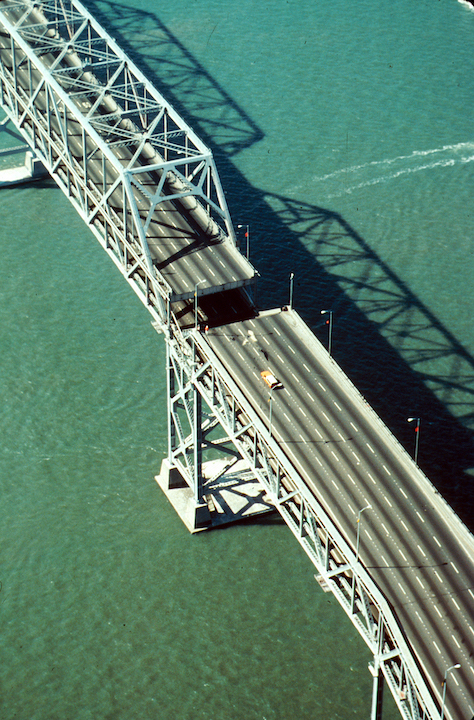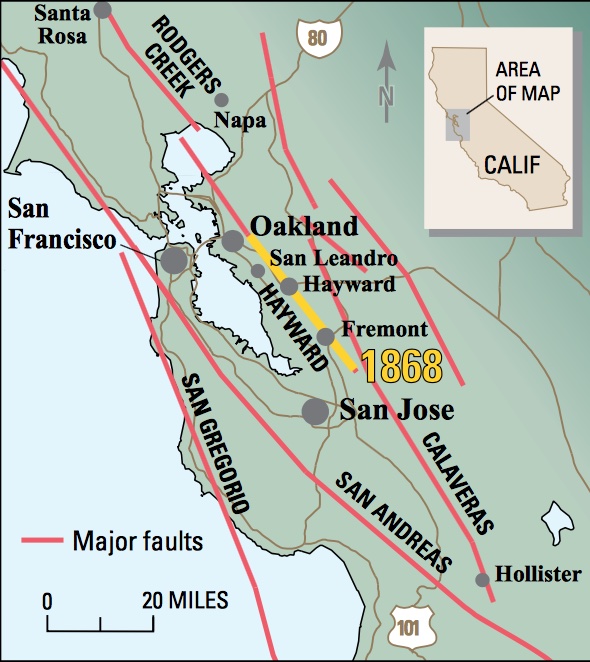Since 2008, the Great ShakeOut earthquake drills remind people to protect themselves in an earthquake. The annual drill falls around the anniversary of a historic Bay Area shock — the Loma Prieta Earthquake of 1989.
By Alka Tripathy-Lang, Ph.D., science writer (@DrAlkaTrip)
Citation: Tripathy-Lang, A, 2021, Living through the Loma Prieta earthquake, Temblor, http://doi.org/10.32858/temblor.216
On October 17, 1989, Harold Tobin, then a graduate student at UC Santa Cruz, was walking out the back door of the Earth Science building on campus when the ground began to shake. Looking over his shoulder, he could see the building move and the windows vibrate. Rattling noises followed him as he stumbled his way along a paved path, trying to stay on his feet as Earth’s unstable surface attempted to overthrow him. The majestic redwood trees for which the campus is known rained down debris. The shaking lasted for no more than 10 or 15 seconds, he says, but it felt like an eternity.
An earthquake had just struck northern California.
Fellow graduate students Marino Protti and Aaron Velasco were the first to evacuate the building. “We were talking by the main glass doors,” says Protti, “and the doors were moving so violently that I thought they were going to break.”
Tottering along, Tobin watched geophysicists-in-training pour out of nearby trailers that housed graduate student offices. In the minutes after the initial quake, subsequent shocks came every few seconds, jarring the students, researchers and faculty gathered outside.
Protti laid down on his back, trying to feel from which direction the aftershocks’ waves were coming, recollects Tobin. Other students joined Protti, functioning as makeshift seismic stations.
Protti, who is currently a seismologist at the Observatorio Vulcanológico y Sismológico de Costa Rica, says he often used to throw himself to the ground to feel aftershocks.
“To us, it was clearly a big earthquake, but nobody recognized that it would have been a really damaging earthquake,” says Tobin of the graduate student chatter in the moments after the first waves rolled through.
In a time before widespread cell phone and internet, about 10 to 15 minutes passed before somebody in a nearby parking lot with a car radio announced that part of the Bay Bridge, which connects San Francisco to Oakland, had collapsed, says Tobin. “That’s when we first recognized how serious of an event it was.”

Tobin and his peers had just experienced the magnitude-6.9 Loma Prieta earthquake, eight miles (13 kilometers) from its epicenter.
With power out all over Santa Cruz, the students organized to go hunting for signs of a surface rupture, although they would find out later that none occurred. As bands of students roved the Santa Cruz Mountains, they came upon homes that had partially or fully collapsed. One homeowner described to the students how his woodstove detached, flew across the room, turned a corner and landed in the kitchen during the quake. “The accelerations were huge,” says Tobin.
The event struck before game 3 of baseball’s World Series between the Oakland Athletics and the San Francisco Giants. It became the first televised earthquake, with people across the United States tuned in for pregame coverage.
Because Loma Prieta stopped the World Series, it became a celebrity quake, says Kim Blisniuk, an earthquake geologist at San Jose State University. But it also has notoriety because of the destruction it wrought throughout the San Francisco Bay Area, she says.
The collapse of part of the Bay Bridge killed one person, and a section of the Nimitz Freeway crumpled, killing 42 people. Those numbers, however, could have been far worse. The quake struck at rush hour, but because numerous baseball fans had already gone home to watch the game or stayed at work late for parties, the roads were relatively clear.
Because the Loma Prieta earthquake affected so many people in myriad ways — from a postponed baseball game to power loss to people stuck in place awaiting help — the event, explains Blisniuk, was very notable.
San Andreas Shock
Near Loma Prieta peak in the Santa Cruz Mountains, the San Andreas Fault tore obliquely below the surface, causing the quake. According to the U.S. Geological Survey ShakeMap, people reported feeling the earthquake as far east as Reno, Nevada and as far south as Oceanside, California. The shaking felt near the epicenter was particularly violent, according to USGS reports and confirmed by Tobin’s story of the flying woodstove.

The San Andreas separates the northwest-moving Pacific plate, which includes the western-most sliver of California, from the North American plate. From the Mendocino Triple Junction that sits off the coast of northern California, the San Andreas wends its way southward through the Bay Area, skirting east of Los Angeles, ending near the Salton Sea of southern California. Similar faults continue southward, into Mexico.
Forecasting future hazard around the San Francisco Bay
However, says Blisniuk, movement in the Bay Area is not confined to a simple, single vertical fault plane.
East of the San Andreas, she says, the Hayward Fault famously cuts through Berkeley’s football stadium. To the north, the Rodgers Creek fault runs northward from the San Francisco Bay along Napa Valley. The Calaveras Fault, which runs east and south of the Hayward Fault, heads toward Hollister.

“We would forecast an earthquake on the Calaveras or Rodgers Creek fault more so than the San Andreas fault,” says Blisniuk, but that’s dependent on paleoseismic studies that help scientists reconstruct past earthquakes on these faults. New data, she says, forces geologists to regularly reassess where we expect to see a big earthquake in Northern California.
Numerous studies, says Blisniuk, show that the Hayward Fault creeps, which means it is always moving. This means it’s generally releasing stress, instead of storing it for a big earthquake.
Nevertheless, she says, the Hayward and other faults in the San Andreas system still pose a problem for the Bay Area because we just don’t know when they will rupture. We can’t predict when earthquakes will happen, she says. Instead, scientists forecast probabilities, like meteorologists forecast the weather.

Earthquake warnings
Although scientists cannot predict future quakes, they have developed a system to warn people when an earthquake has begun, ideally several seconds before strong shaking arrives. Since the Loma Prieta earthquake, the U.S. West Coast has adopted this earthquake early warning system, known as ShakeAlert.
The biggest value of those few seconds that ShakeAlert provides may not be the seconds to drop, cover and hold on, says Tobin, now state seismologist of Washington and director of the Pacific Northwest Seismic Network, which is part of ShakeAlert. “It gives you that mental second or two to say, ‘Okay, earthquake warning, what am I supposed to do during an earthquake?’” he explains. A few seconds can prime people to take protective action instead of freezing, panicking, or doing the wrong thing when shaking starts. The most important action is to protect your head, he says.
Tobin recommends having a family plan of where to meet after an earthquake, if internet and electricity are down and getting in touch is difficult.
Blisniuk says she encourages people to have water, food, flashlights, batteries and blankets. “Make sure you have at least five gallons of water readily available so you can wash dishes, or make pasta or ramen,” she says, although she recommends having 60 gallons on hand. Having the necessities to live for one or two days, she says, will save you from having to fight traffic when, likely, the traffic lights aren’t working and everyone else is rushing out for basics.
And don’t forget that practice makes perfect. Today is the Great Shakeout, a worldwide earthquake drill held annually on the third Thursday of October. Millions of people will be participating in the annual drill, including Blisniuk and Tobin. Practicing protective action, coupled with preparation, goes a long way toward earthquake safety. To register, click here.
- Living through the Loma Prieta earthquake - October 21, 2021
- The Great Quake Debate: an interview with seismologist and author Susan Hough - August 27, 2020
- Salton Sea Swarm quiets down - August 12, 2020
